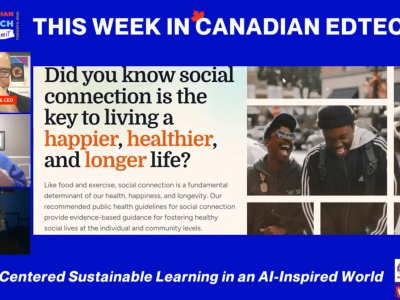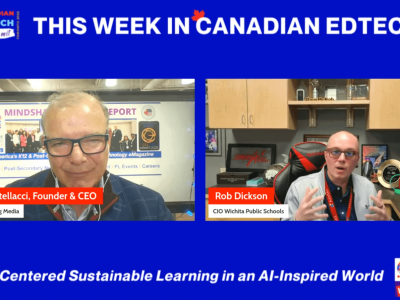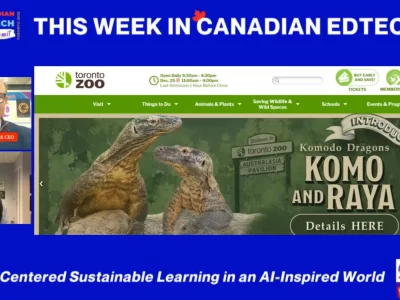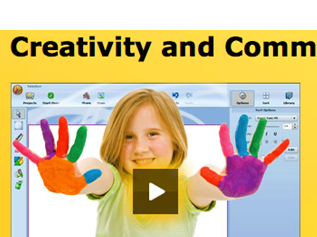By Timothy Gard, K-12 Editor, Educator, Toronto District School Board
Twitter: mindsharek12
Part 1 of 3
 Howard Gardner in his book entitled, Five Minds for the Future, writes about what he thinks will be the kinds of minds that are most important today and even more so tomorrow (Gartner). This book has a lot to say about each ‘type’ of mind however it’s two particular types of mind that I’m interested in bringing to the fore in this short article – The Synthesizing and The Creating Mind. If you understand that innovation is really a symphony of those two types of minds then you’ll readily understand the purpose of understanding these two ‘minds’ with regards to innovation. To innovate at its very basic level means to ‘renew’ or to alter so as to make something new. It can also mean to introduce something that is new. In short, an innovator is someone who introduces a new idea, or recreates or repackages an old idea so as to effect change in any given context.
Howard Gardner in his book entitled, Five Minds for the Future, writes about what he thinks will be the kinds of minds that are most important today and even more so tomorrow (Gartner). This book has a lot to say about each ‘type’ of mind however it’s two particular types of mind that I’m interested in bringing to the fore in this short article – The Synthesizing and The Creating Mind. If you understand that innovation is really a symphony of those two types of minds then you’ll readily understand the purpose of understanding these two ‘minds’ with regards to innovation. To innovate at its very basic level means to ‘renew’ or to alter so as to make something new. It can also mean to introduce something that is new. In short, an innovator is someone who introduces a new idea, or recreates or repackages an old idea so as to effect change in any given context.
Most everyone would agree that education seems to be in a constant flux of change. You can either ‘go with the flow’ or get swallowed up in the tsunami of change that is happening, and is going to happen at a much faster rate than it is now. We need teacher-innovators. These teacher-innovators are the individuals who adapt to change. I would argue that in many regards these individuals flow seamlessly with change because change is by nature disruptive and innovation lives alongside disruption.
Teacher-Innovators are teachers who have the synthesizing and creative minds; they have the ability to integrate ideas from different contexts into a coherent whole and they communicate the result to other teachers effectively and cogently. They also have the capacity to uncover and bring clarity to new problems, questions and phenomena in education. The two minds work in synchronicity in a teacher-innovator; the two minds when they are allowed to grow and flourish bring renewal to a school, and if they are harnessed as a unified cadre they can bring renewal to a district. But they are hardly encouraged and cultivated in our current system of education. There are barriers and I have too often seen those with the capacity to become these types of teachers – the teacher-innovators – leave the profession or close up and develop very small pockets of change in a very small context. Or worse, they become part of the ‘framework’ of ‘business as usual’ because their spirits have been crushed under the weight of bureaucracy and educational polity and they themselves become part of the problem.
To become an innovator in education at the practitioner level is difficult at best. Teacher-Innovators are few and far between. This is not because teachers are by their nature incapable of innovating. Quite the contrary – Teachers are by nature innovators if you let them innovate. Let me outline below some key ideas about innovation in education. These ideas can cultivate a teaching environment that creates, encourages and sustains teacher-innovators. These fertile grounds are more easily created then one would suppose; we need these people or we’ll never move out of the flux of shallow thinking into a culture that is dominated by bureaucrats who encourage the adage, ‘business as usual’. The right factors for fostering innovation among teachers can be found below. This is in no way exhaustive, but I do believe that these ideas are necessary building blocks for fallow ground in the chance to build ‘redwoods’ instead of ‘ragweed’. And at the very least they should stimulate discussion at a higher level about our need to cultivate schools where teachers are free to change, to innovate, to inspire students to themselves become change leaders and innovators wherever they may find themselves contributing to society.
We Need Change Leadership
You cannot hope to encourage innovation at your school if you don’t embrace the simple fact that we cannot continue to embrace education in its current form. The world is changing and without belabouring to death the details about 21st Century learning and all of the nuances of that movement we know inherently that the world is moving at a much faster clip and ideas are a dime a dozen. As Canadians we tend to move at a much slower clip when it comes to change and innovation. This is in itself not necessarily a bad thing because you do tend to learn from the mistakes of others, but you also tend to lean on the ‘coat-tails of others’ as well. We are not a nation of ‘movers and shakers’ because I believe we have been cauterized by the huge risk-taking that happens to the South of us. Why innovate? We can just wait and see what happens next door to us and then assimilate those ideas into Canadian terms and forms. I’m being a bit harsh. Indeed, we do have innovation happening however I think as a nation with the highest percentage of post-secondary educated people in the world we can do much better. But perhaps therein lays the problem. Are we not creating environments in education where students feel that the world is theirs to change for the better; where they can make a difference with new and exciting ideas? Perhaps not. And perhaps we need to realize that the world is changing quickly; there is no room for ‘business as usual’. If you don’t believe that, look at what happened to the behemoths of technology in this country – NORTEL and RIM.
What we need is a clear understanding of what is at risk if we don’t manage the change that is happening around us. Again, Michael Fullan has written laborious amounts on change management in education and so I won’t get into any great detail here. I will say however in light of the fact that we are in a changing world where other nations and peoples are making every effort to innovate so as to adapt to a world that is changing our schools are mired in yesteryear. Why? I do believe that part of the reason is that we are in need of a whole new transformational paradigm for teachers. You might wonder what this has to do with the sub-title but let me explain. Generally, the leaders in our educational institutions were former teachers and they more often than not carry forward the ideologies that they have lived in during their tenure as teachers. In fact, I have noted on more than one occasion that if these leaders are not changing with the times by getting involved in professional dialogue, keeping up with current research and applying it to their leadership of a school or district then the result can be devastating. This is simply because they are often carrying forward outdated and outmoded ideas that have been tested and found wanting in schools and districts that are led by true change leaders.
We like to think that the ‘gatekeepers’ to our school are principals but really the ‘gatekeepers’ to our schools are the contexts that these leaders have been exposed to and have either knowingly or unknowingly adopted. The ‘gatekeeper’s then are thought patterns that have never been challenged or changed; change is simply a word that gets bandied about when you want to impress your professional colleagues. If we change the teaching paradigm and encourage teachers to be practitioners on the move; innovators who are on the ‘watch for a new and powerful way to do something’ than we will after a decade of this attitude see that schools will also become much more likely to be innovative and students and teachers learning and teaching in exciting environments. These innovators are synthesizing and creating; like will produce like – teachers will produce leaders who are change leaders. And change leaders love innovation and innovation loves change.
Risk Taking is Not a Bad Thing
I remember my supervising teacher during my second practicum as a student teacher encouraging me to take risks in my teaching. That was liberating! I thought that teaching was about a set way of doing things in a very controlled context and that my many years of exposure to many different teachers was about emulating their behavior without challenge. Wrong! She was wise enough to see that I was not giving what I could give and that I was full of the fear of failing. But we all know that failing is inevitable and so we should simply embrace it as a means to change ones thinking about something; to reorient an approach and try again. But how do we encourage risk taking in education when so many teachers are bound by ‘covering the curriculum’. Indeed, it really does come down to what you mean by ‘covering’ because simply making sure that you touch all of the key points in the curriculum does not necessarily facilitate good teaching and learning. If every student starts at his or her own point of learning then we can pretty much assume that he or she will not gain or move forward if we ‘fling’ the curriculum at them ad nauseum.
If we want to encourage risk taking in teaching and allow teachers to innovate we must ensure that they have an environment that is supportive, encouraging and free of red tape. The last two words of the previous sentence are my personal nemesis. Red tape is often a cover for ‘we-have-no-idea-what-we’re-doing-so-we’ll-hide-until-it –becomes-clear’ ideology. Or red tape is the cumulative result of dealing with broken ideas and the resultant back-lash. Regardless, we need to free the working environment so that teachers can explore fresh ideas alongside colleagues who can question, challenge and refine those ideas. We know and have often heard that that one great idea came out of a myriad of ideas that failed to materialize – but that one great innovative idea will not materialize if we don’t take the risks, plunge headlong into the upstream swim.
This headlong swim against the stream means that teachers can and should bring their life experiences into the classroom. In my experience teachers who have had a previous career tend to have a more dynamic classroom. The reason is fairly simple: real life experiences bring previous knowledge into a deep intersection with pedagogy. In short, new ideas come from a breadth of knowledge and once the new teacher gains expertise in pedagogy then you have a dynamic that can easily become innovative (Dyer, Gregersen, and Christensen 33) Breadth of knowledge plus specialized knowledge in a particular field will facilitate a higher probability of innovation. This is all wonderful of course but it cannot and will not happen if teachers don’t take risks. And this cannot happen if the administration at a school doesn’t encourage risk-taking.
True Innovators Are Disruptive
Disruptive? Really? You can imagine the disdain creeping across an administrators face if you mentioned this in a meeting. But it’s true, especially in education. And to make matters worse if a teacher disrupts his/her environment you can only imagine what his/her peers think. They don’t like to have their ‘boats rocked’ especially if it grabs attention and changes the learning environment so that adaptation is not easily attainable. We are creatures of habit and if we don’t encourage the innovators around us then we’ll easily sink into the abyss of boredom and ‘business as usual’. We simply cannot risk this especially for students who by nature are explorers and survivors. They want to be challenged; they want to look at information from different ways and from different perspectives. But if we don’t innovate and if we don’t create a culture of innovation at our schools then it will be ‘business as usual’ and the learning environment will not flourish but it will become stagnant which unfortunately is an all too common context for far too many students.
By disruptive I certainly don’t mean that we abandon everything for the sake of change. By disruptive I mean we change up our way of teaching and leading. If you keep doing the same thing over and over the same way you’ve always done it in the past then your assuming that the world isn’t changing and that the students you received ten years ago are growing up in similar contexts with similar world views. Of course that’s ludicrous. Or you may have the idea that ‘what’s not broken shouldn’t be fixed’. In fact, Canada does relatively well on international standardized tests compared to other nations. We’re normally in the top five or so and we think that because of our decent scores we don’t need to change a thing in our teaching and learning environments. All is good in the Land of Oz. Well Dorothy, technology is rapidly changing the whole context of our world. Let me give you a very small example. In one of my media classes I had tasked grade 5 students with presenting a non-fiction topic of choice in a non-linear format. At the end of the presentations the other grade 5 students are given the opportunity to question and challenge the presenter’s material with good, solid high-level critical thinking. Their ‘job’ was to make the person who was presenting ‘think’ about their topic. In one particular case, one of the students in the audience questioned the use of an image that the presenter claimed he created. Various students weighed in with their opinions both for and against the presenters claim of ownership. In response the questioner did a quick query by using a reverse image search query and then pulled up on his computer that very same image from a website that the presenter had ‘borrowed’. An interesting dialogue ensued with the presenter attempting to challenge this claim by stating that it was possible that the image on that particular website ‘borrowed’ his image from his gaming website. Issues of intellectual property rights and copyright became the focus of the balance of the class and students got a first-hand look at the wealth of information they had available to them in both positive and negative ways. My point? I couldn’t have scripted this same scenario without allowing the students to disrupt the standard ways of thinking that often stagnate our classrooms. That particular student decided – as a ten year old – to do something rather innovative. He decided to become a bit disruptive by ‘thinking outside of the box’ and to find out for himself whether the image did in fact belong to the other student. I’ll leave the rest of that conversation to your imagination.
As you no doubt noticed at the top of this article, this is part one of three parts. I cannot possibly bring it all together in one long article and to be honest I’m still thinking about how to put all of my thoughts down in these three pieces. Regardless, stay tuned for the next two pieces in the June and Summer editions of The MindShare Learning Report!
If you feel that you have some interesting stories to share about innovation at your school please feel free to send me an email at my address below! I’ll be sure to digest them and I just might share your story in my next two pieces!
__________________________________
References
Jeff Dyer, Hal Gregersen and Clayton M. Christensen. The Innovator’s DNA: Mastering The Five Skills of Disruptive Innovators. Boston: Harvard Business Review Press, 2011. Pg. 33.
Howard Gartner, Five Minds for the Future, Boston: Harvard Business School Press, 2006.








